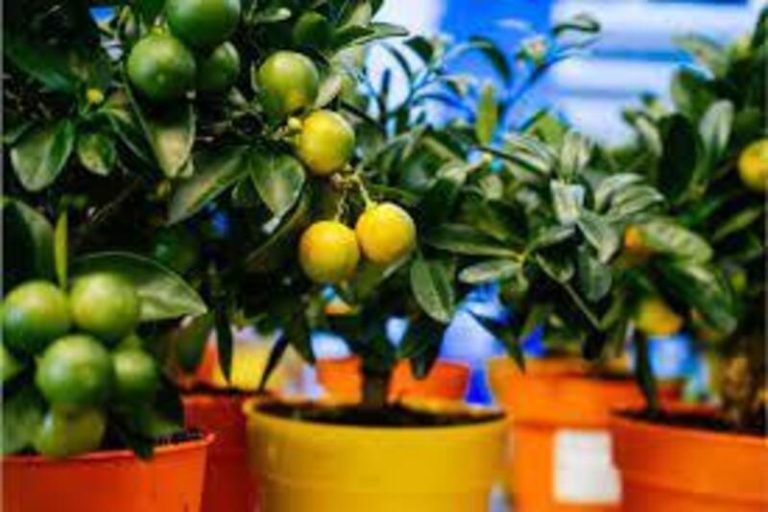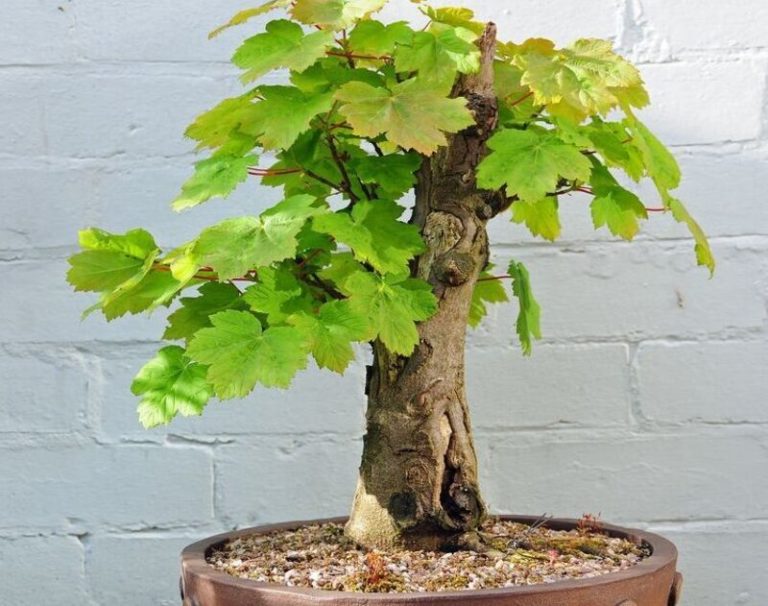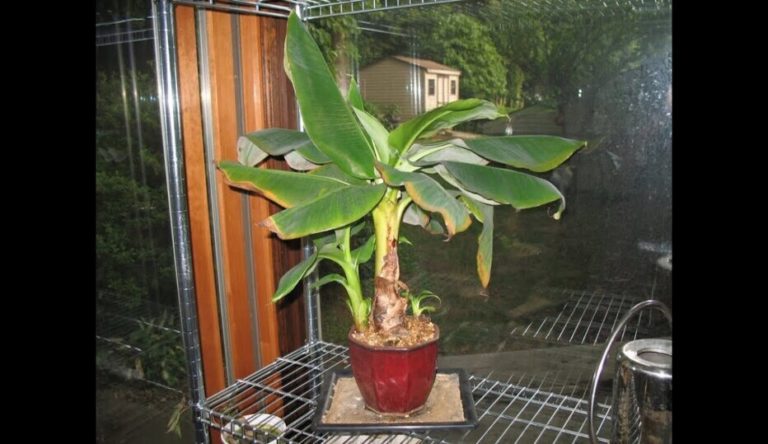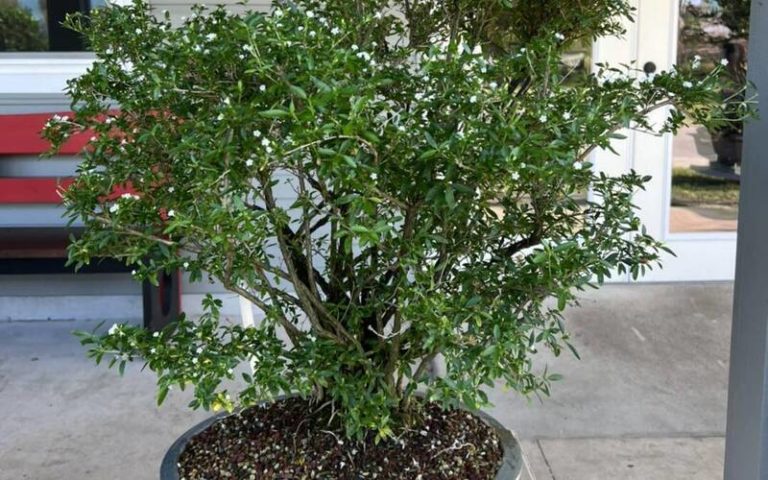Jaboticaba Bonsai: A Unique and Beautiful Plant to Cultivate
Brazil is the home of Jaboticaba Bonsai, a type of bonsai tree. This plant is unusual because it grows fruit right on its trunk and branches. This makes it a popular choice among people who like to grow bonsai. Jaboticaba Bonsai can be grown inside or outside, and it can be a beautiful addition to any home or yard.
What is Jaboticaba Bonsai?
A small, dark purple fruit called jaboticaba grows on trees in Brazil. The fruit tastes sweet and sour, and many jams, jellies, and wines use it as an ingredient. The Jaboticaba tree is also often grown in parks as a pretty plant.
Jaboticaba Bonsai is believed to have originated in Brazil, where it has been cultivated for centuries. The practice of growing Jaboticaba as a bonsai tree began in the 20th century, and it has become increasingly popular among bonsai enthusiasts worldwide.
History and Origins of Jaboticaba Bonsai
Small, dark purple fruits called jaboticaba grow on trees in Brazil. The fruit tastes sweet and sour, and it is often used to make jams, sauces, and wines. The Jaboticaba tree is also often grown in parks as a decorative plant.
Jaboticaba Bonsai is believed to have originated in Brazil, where it has been cultivated for centuries. The practice of growing Jaboticaba as a bonsai tree began in the 20th century, and it has become increasingly popular among bonsai enthusiasts worldwide.
Types of Jaboticaba Bonsai
There are numerous varieties of Jaboticaba Bonsai, each with their own distinctive characteristics. Here are some of the most prevalent varieties:
- Myrciaria cauliflora: This type of Jaboticaba Bonsai is characterized by its dense, compact foliage, and beautiful pink flowers. It is also known for producing large, juicy fruits directly on its trunk and branches.
- Myrciaria jaboticaba: This type of Jaboticaba Bonsai has smaller leaves and a more delicate appearance than Myrciaria cauliflora. It is known for its ability to produce fruit directly on its branches and has a beautiful, smooth reddish-brown bark.
- Plinia cauliflora: This type of Jaboticaba Bonsai is a dwarf variety that is popular for indoor cultivation. It has a compact growth habit, small leaves, and produces fruit directly on its trunk and branches.
- Plinia trunciflora: This variety of Jaboticaba bonsai is distinguished by its compact, lustrous leaves and its lovely white flowers. It produces tiny, edible, purple fruits with a sweet and tart flavor.
There are numerous other varieties of Jaboticaba Bonsai to choose from in addition to those listed above. Each type has distinct characteristics; therefore, it is essential to conduct research and select the appropriate type for your requirements and growing conditions.
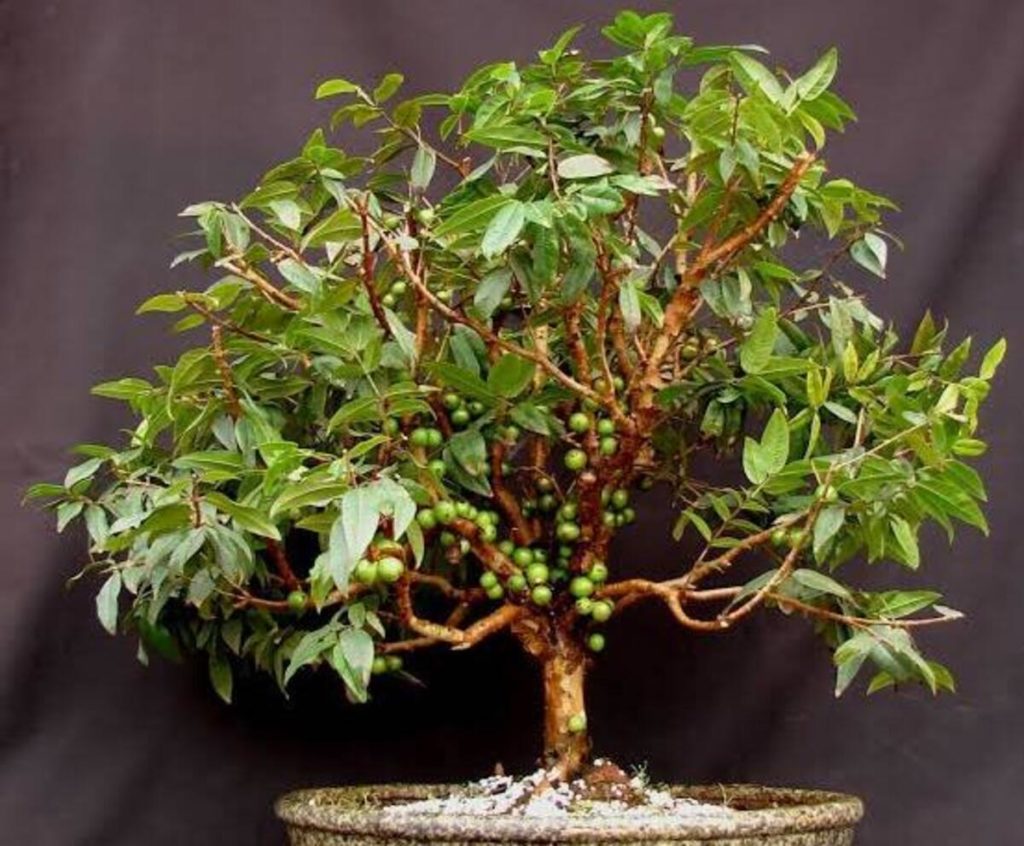
Jaboticaba Bonsai and Its Symbolism
Jaboticaba Bonsai is a beautiful plant that has been cultivated for centuries and has significant symbolism in different cultures. Here are some of the symbolic meanings associated with Jaboticaba Bonsai:
Prosperity and abundance: In many cultures, the Jaboticaba fruit is associated with abundance, prosperity, and fertility. Therefore, the Jaboticaba Bonsai is often seen as a symbol of good luck and prosperity, making it a popular choice for home and office decor.
Longevity: The slow-growing nature of the Jaboticaba Bonsai also makes it a symbol of longevity and endurance. The tree’s ability to bear fruit directly on its trunk and branches is a testament to its strength and resilience, making it a powerful symbol of endurance.
Family and community: Jaboticaba trees are frequently cultivated in community gardens, and their fruit is commonly shared with friends and family. The Jaboticaba Bonsai is therefore viewed as a symbol of family, community, and unity. It represents the concept of collaboration and mutual support, which is fundamental to many cultures.
Spiritual growth: Some people believe that cultivating a Jaboticaba Bonsai can help promote spiritual growth and introspection. The slow-growing nature of the tree encourages patience and mindfulness, while its ability to bear fruit directly on its trunk and branches symbolizes the connection between the physical and spiritual worlds.
Jaboticaba Bonsai is not only a beautiful plant but also a symbol of good luck, prosperity, longevity, family, community, and spiritual growth. It is a meaningful addition to any home or office and can bring positive energy and symbolism into your life.
Characteristics of Jaboticaba Bonsai
Jaboticaba Bonsai is a unique and beautiful plant with several distinctive characteristics. Here are some of the key features of Jaboticaba Bonsai:
- Dense foliage: Jaboticaba Bonsai has dense foliage that gives it a lush and full appearance. The leaves are small and oval-shaped, with a glossy dark green color.
- Bark: The bark of Jaboticaba Bonsai is smooth and has a reddish-brown color, which contrasts beautifully with the green foliage.
- Fruit: The ability of Jaboticaba Bonsai to bear fruit directly on its trunk and branches is one of its most distinguishing characteristics. The fruit is compact, round, purple-black, and grape-like in taste.
- Slow-growing: Bonsai Jaboticaba is a slow-growing plant that requires perseverance and attentive cultivation. It may take the tree several years to mature and bear fruit.
- Size: The size of Jaboticaba Bonsai can vary depending on the type and growing conditions. Some varieties can reach up to 10 feet tall, while others are dwarf varieties that are suitable for indoor cultivation.
- Shaping: Jaboticaba Bonsai can be trained and shaped in various styles, including informal upright, formal upright, slanting, and cascade. The tree’s ability to produce fruit on its trunk and branches makes it an excellent choice for bonsai enthusiasts who want to create a unique and beautiful specimen.
Jaboticaba Bonsai is a distinct and gorgeous plant with dense foliage, reddish-brown bark, and the capacity to bore fruit directly on its trunk and branches. It is a slow-growing plant that requires meticulous cultivation and can be shaped into various bonsai designs. The tree’s unique characteristics make it a favorite among bonsai devotees and a stunning asset to any home or garden.
How to Grow Jaboticaba Bonsai?
Growing Jaboticaba Bonsai can be a rewarding and enjoyable experience. Here are some steps you can follow to grow your Jaboticaba Bonsai:
- Choose the right type of Jaboticaba Bonsai: There are several varieties of Jaboticaba Bonsai to choose from; therefore, it is important to select the type that is optimal for your growing conditions and preferences.
- Select a suitable container: Choose a container that is big enough to allow your Jaboticaba Bonsai to grow and develop its root system. It should have proper drainage holes to prevent waterlogging.
- Soil: Utilize soil that drains well and is abundant in nutrients. You can create suitable soil by combining peat moss, perlite, and sediment in equal amounts.
- Watering: Jaboticaba Bonsai requires consistent watering. Water the tree when the soil feels dry to the touch. Avoid overwatering, as this can lead to root rot.
- Fertilizer: Utilize a balanced fertilizer to supply your Jaboticaba Bonsai with the required nutrients. During the growing season, fertilize the soil every two to three months.
- Pruning: Prune your Jaboticaba Bonsai regularly to maintain its shape and promote healthy growth. Remove dead or diseased branches and trim back overgrown foliage.
- Training: Train your Jaboticaba Bonsai to grow in the desired shape and style. Use wire to gently guide the branches and trunk into the desired position.
- Sunlight: Jaboticaba Bonsai requires bright, indirect sunlight to thrive. Place your tree in a location that receives partial sun, preferably in the morning or afternoon.
Growing Jaboticaba Bonsai requires proper care and attention. Choose the right type of Jaboticaba Bonsai, select a suitable container and soil, water and fertilize regularly, prune and train the tree, and provide it with the right amount of sunlight. With patience and care, you can grow a beautiful and healthy Jaboticaba Bonsai that will thrive for years to come.
Benefits of Jaboticaba Bonsai
Jaboticaba Bonsai offers several benefits, both aesthetic and practical. Here are some of the benefits of growing Jaboticaba Bonsai:
Aesthetic value: Unique and gorgeous, Jaboticaba Bonsai lends a touch of elegance and sophistication to any home or garden. Bonsai devotees favor it for its dense foliage, reddish-brown bark, and ability to produce fruit on its trunk and branches.
Stress relief: Caring for a Jaboticaba Bonsai can be a relaxing and therapeutic activity. Taking the time to water, prune, and train your tree can help reduce stress and promote mental well-being.
Air purification: Like all plants, Jaboticaba Bonsai helps purify the air by removing toxins and pollutants. This can help improve indoor air quality and promote better health.
Fruit production: The Jaboticaba Bonsai tree bears tiny, round, purplish-black fruits with a grape-like sweetness. Fruit harvesting can be a rewarding and enjoyable activity.
Learning opportunity: Growing Jaboticaba Bonsai can be an educational experience for both adults and children. It offers the opportunity to learn about plant care, horticulture, and the natural world.
Environmental benefit: Growing plants, including Jaboticaba Bonsai, can help reduce carbon dioxide levels in the atmosphere and promote a healthier environment.
Jaboticaba Bonsai offers several benefits, including aesthetic value, stress relief, air purification, fruit production, learning opportunities, and environmental benefits. It is a unique and beautiful plant that can enhance your home or garden and provide many practical benefits as well.
Styling and Design of Jaboticaba Bonsai
Styling and designing your Jaboticaba Bonsai can be a creative and rewarding process. Here are some styling and design tips to help you create a beautiful and unique Jaboticaba Bonsai:
- Choose the right style: There are several bonsai styles to choose from, such as formal upright, informal upright, slanting, cascade, and semi-cascade. Choose a style that suits the shape and size of your Jaboticaba Bonsai.
- Select a suitable container: Choose a container that complements the style and design of your Jaboticaba Bonsai. The container should be proportional to the size of your tree and should have a simple and understated design to avoid distracting from the beauty of the tree.
- Balance the tree: Achieve balance in your Jaboticaba Bonsai by ensuring that the branches are evenly spaced and that the foliage is not too heavy on one side of the tree.
- Create depth: Add depth to your Jaboticaba Bonsai by creating layers of foliage. Use branches with varying lengths to create a sense of depth and perspective.
- Prune and wire: Prune your Jaboticaba Bonsai regularly to maintain its shape and promote healthy growth. Use wire to gently guide the branches and trunk into the desired position.
- Use accent plants: Add interest and visual appeal to your Jaboticaba Bonsai by incorporating accent plants, such as moss or small flowers, into the design.
- Consider the environment: When designing your Jaboticaba Bonsai, consider the environment in which it will be displayed. Choose a location that receives the right amount of sunlight and is free from drafts and extreme temperatures.
Styling and designing your Jaboticaba Bonsai is a creative process that requires patience and attention to detail. Choose the right style, container, and location, balance the tree, create depth, prune and wire, and incorporate accent plants to create a beautiful and unique Jaboticaba Bonsai that will enhance your home or garden.

How to Care and Maintain Jaboticaba Bonsai?
Caring for and maintaining your Jaboticaba Bonsai is crucial for its health and longevity. Here are some tips for caring and maintaining your Jaboticaba Bonsai:
- Watering: Jaboticaba Bonsai needs to be watered regularly to keep the soil moist but not waterlogged. Water the tree deeply and allow the soil to drain completely. Water the tree more frequently during the growing season and reduce watering during the dormant season.
- Fertilizing: Jaboticaba Bonsai requires regular fertilization to promote healthy growth and fruit production. Use a balanced fertilizer during the growing season, and reduce fertilizer application during the dormant season.
- Pruning: Regular pruning is essential to maintain the shape and size of your Jaboticaba Bonsai. Remove any dead or diseased branches and trim the foliage to maintain balance and shape.
- Wiring: Use wire to gently guide the branches and trunk into the desired position. Be careful not to wire too tightly as this can damage the tree.
- Pest and disease control: Keep an eye out for pests and diseases that can affect your Jaboticaba Bonsai. Use an appropriate pesticide or fungicide to control any pests or diseases that you find.
- Sunlight and temperature: Jaboticaba Bonsai requires bright, indirect sunlight to thrive. Avoid exposing the tree to direct sunlight, which can cause leaf burn. Keep the tree in a location that is free from drafts and extreme temperatures.
- Repotting: Repot your Jaboticaba Bonsai every 2-3 years to refresh the soil and promote healthy growth. Choose a suitable potting mix and container that is slightly larger than the previous one.
Caring for and maintaining your Jaboticaba Bonsai requires regular watering, fertilizing, pruning, wiring, pest and disease control, and attention to sunlight and temperature. By following these tips, you can ensure that your Jaboticaba Bonsai remains healthy, vibrant, and beautiful for years to come.
Jaboticaba Bonsai care sheet
| Aspect | Care Tips |
|---|---|
| Watering | Maintain soil moisture without overwatering. Reduce irrigation during winter. |
| Fertilizing | Apply a balanced fertilizer during growth and less during winter. |
| Pruning | Keep your Jaboticaba Bonsai in shape by pruning regularly. Trim dead or diseased branches and foliage to preserve balance and shape. |
| Wiring | Gently guide the branches and trunk using wire. Wiring too tightly might harm trees. |
| Pest and disease control | Pests and diseases can harm your Jaboticaba Bonsai. Control pests and illnesses with the right pesticide or fungicide. |
| Sunlight and temperature | Jaboticaba Bonsai needs bright, indirect sunshine. Avoid sunburning the tree. Avoid drafts and severe temperatures for the tree. |
| Repotting | Every 2-3 years, repot your Jaboticaba Bonsai to renew the soil and promote healthy development. Choose a good potting mix and container that is somewhat larger than the last one. |
By following these care tips, you can ensure that your Jaboticaba Bonsai remains healthy, vibrant, and beautiful for years to come.
FAQ:
Q: What is Jaboticaba Bonsai?
A: The Jaboticaba plant is a tropical fruit tree that grows in Brazil. This plant is used to make a bonsai tree.
Q: How often should I water my Jaboticaba Bonsai?
A: Water your Jaboticaba Bonsai regularly to keep the soil moist but not waterlogged. Reduce watering during the dormant season.
Q: What is the best soil mix for Jaboticaba Bonsai?
A: A well-draining soil mix that is rich in organic matter, such as a mix of Akadama, pumice, and lava rock, is a popular choice for growing Jaboticaba Bonsai.
Q: How often should I fertilize my Jaboticaba Bonsai?
A: Fertilize your Jaboticaba Bonsai regularly during the growing season with a balanced fertilizer. Reduce fertilizer application during the dormant season.
Q: Can Jaboticaba Bonsai be grown indoors?
A: Jaboticaba Bonsai can be grown indoors, but it requires bright, indirect sunlight to thrive. Avoid exposing the tree to drafts and extreme temperatures.
Q: When should I prune my Jaboticaba Bonsai?
A: Prune your Jaboticaba Bonsai regularly throughout the year to maintain its shape and size. Remove dead or diseased branches and trim the foliage to maintain balance and shape.
Q: How do I wire my Jaboticaba Bonsai?
A: Gently guide the branches and trunk into the desired position using wire. Be careful not to wire too tightly, as this can damage the tree.
Q: What pests and diseases should I watch for in Jaboticaba Bonsai?
A: Keep an eye out for pests like spider mites and mealybugs and diseases like root rot and leaf spot. If you find pests or diseases, kill them with the right pesticide or fertilizer.
Q: When should I repot my Jaboticaba Bonsai?
A: Repot your Jaboticaba Bonsai every 2-3 years to refresh the soil and promote healthy growth. Choose a slightly larger container and a suitable potting mix.
Also Read:


